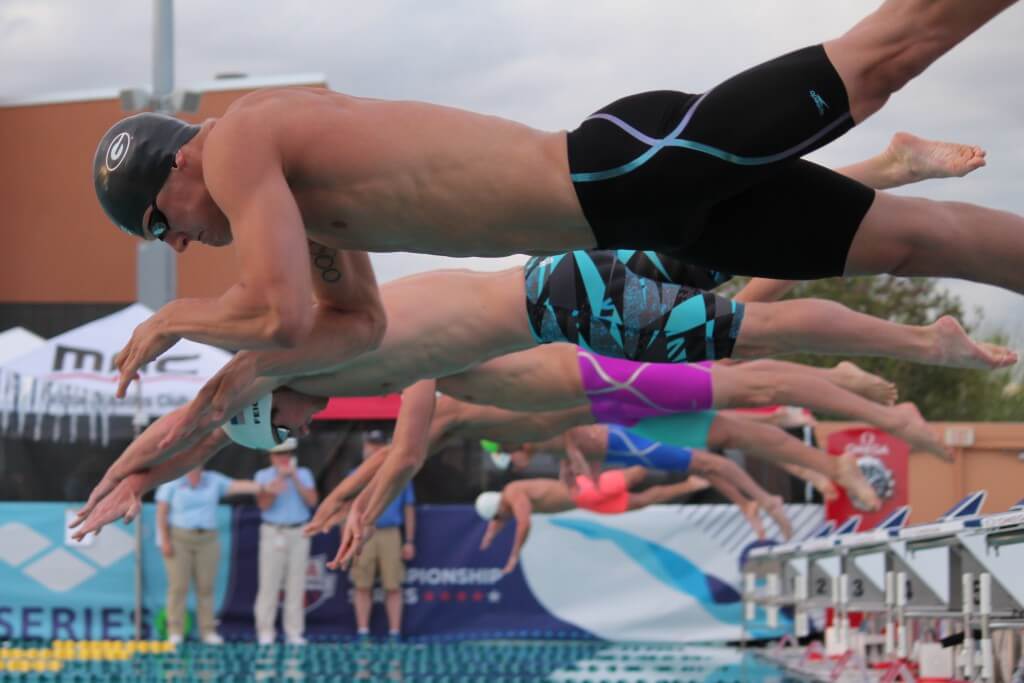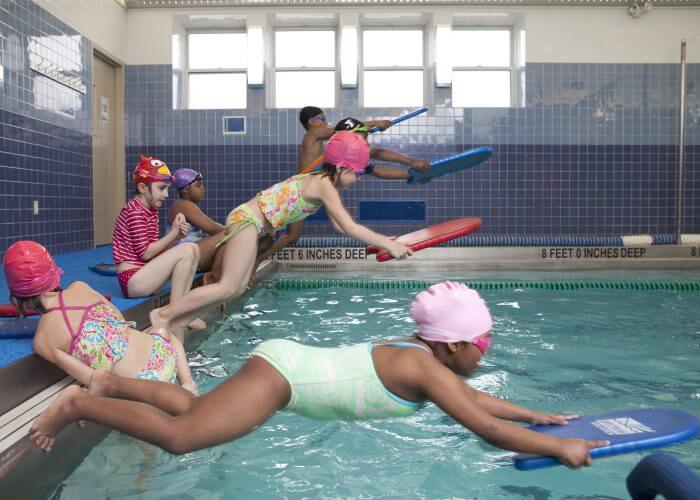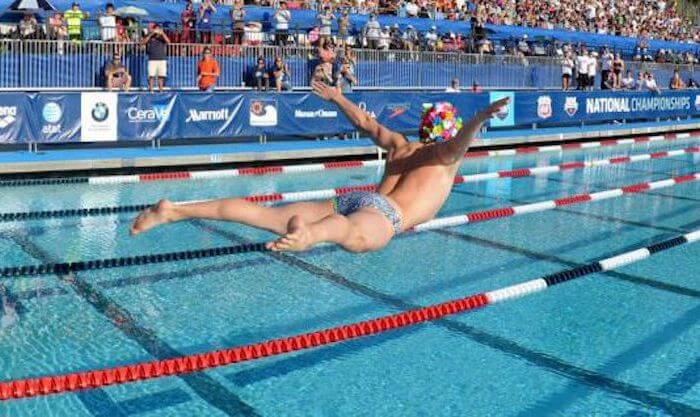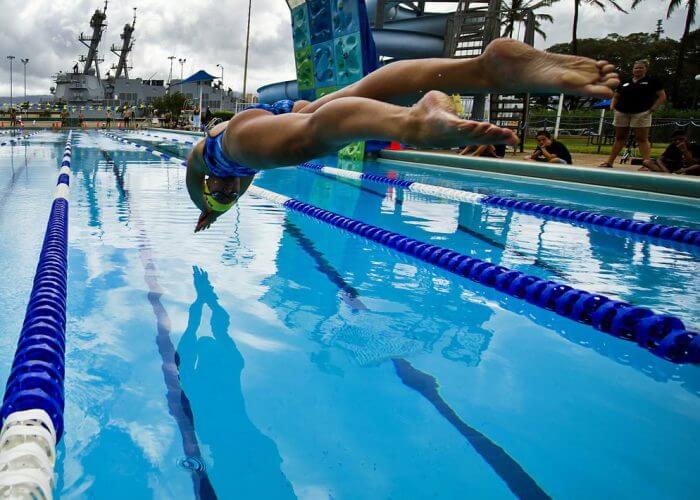Learning to Dive: Trusting Yourself in Swimming

By Erin Himes, Swimming World College Intern
As I hopped in my local pool while on winter break this week, I looked over at the club team practicing with younger kids. They were working on sprints from the blocks, and I watched as kid after kid bellyflopped into the pool. I instantly thought back to when I was in that place. I, now a collegiate swimmer, had been club swimming for three years before I mastered diving. I was nine years old before I ever flawlessly dove into the pool without lifting my chin.

Photo Courtesy: Chasi Annexy
When you think about it, learning to dive is terrifying. To believe when someone tells you that if you put your chin down and don’t watch what’s happening you will be okay just doesn’t sound real. It was a source of anxiety for me. Learning to trust other people’s knowledge and having confidence in my own ability to do it did not come easy, clearly, as I struggled through endless private lessons centered on diving.
But when I thought about it today, I saw that the process of learning to dive parallels many of the lessons I learned much later from swimming. Diving as a kid is something we’re afraid of or that often makes us nervous. For me, this was the same effect racing had later on. Just as I once had to trust a coach who said if I put my head down I would dive, I later struggled to trust a coach who said if I believed I could go best times, I would. As I once learned to have enough confidence to just go for that first dive, I later learned that the only way I would drop time is if I believed I could do it and went for it.

Photo Courtesy: Tyler Clary
Diving into a pool for the first time, you’re faced with three options: to succeed, to bellyflop and be in pain, or to give up and jump. These are the options we’re given through the rest of our swimming careers too. Sometimes, we do something special or that we’ve never done before. It’s what makes all the hard work and growth so worth it. Other times, we flop. We try to do what we think is right, only to find ourselves in a lot of pain after a race with no results to show for it.
But the worst of all is when we give up. As a summer league coach, I was always much happier when a kid tried to dive and didn’t quite make it. The same is true later in our swimming careers. Giving in to the pain of a race or letting your technique slip because you’re afraid of failing is never the way to do it. Just as we each learned what to differently to dive correctly from bellyflopping, we learn the most from when we fall on our faces, not from when we give in to the pressure.

Photo Courtesy: Michael R. Holzworth, TSgt, USAF
These lessons we learn in the first months (or years, if you’re me) of swimming are the ones that carry us far past the early years. Learning to trust yourself does not come easy at all, but it is the only way to succeed in a sport as mental as this one. If you believe you can do it and do anything in your power too, you’ll either succeed or fail, but either way you’re going to learn something valuable that will make you better later. So tomorrow when you head to Christmas training or next month at that big meet, remember that if you once believed you could dive when you never had, you can definitely do the things that seem impossible now.
All commentaries are the opinion of the author and do not necessarily reflect the views of Swimming World Magazine nor its staff.




I like your ideas. It’s very useful to look at what you fear in light of what you used to fear and now do with ease. t’s useful to look at failure from the perspective of a baby learning to walk. They fail, the cry, they get up and fail and cry. They then get one step right. and then fail. And get up again. And fail. And wait a while or crawl a while. They watch those who walk proficiently. and then they get up and walk five steps, often the cheers of a parent. Then they get it. And often no one ever tries that hard against so many failure experience again in their lives! Great parents and great coaches are a lot more rare in developing the right environment than we might suppose. Steve Job’s parents were very very rare in both nurturing a unique environment and leaving him alone to fail of succeed on his own terms. Studies show that training wheels on bicycles delay of ten by noths a child’s ability to ride on two wheels. Coaches giving 10×100’s@1:30 often delay the swimmer’s ability to set his own goals for each lap they swim and teach mediocrity by default as your example of kids belly flopping. A simple hoop allows me to teach starts in a few minutes to two-year-olds! I even made an extension to re-teach our college swimmers. The great coach and parent manipulates the environment without manipulating the person. At the toughest level I look at the lack of feedback in areas of swim teaching and training and cringe. This is why I make self video devices and hand them to the kids — EyeSwims I call them. It’s why I sell pace lights. It’s why we just picked up and are helping XMetrics that puts the stroke count and tempo and pace in the ear of swimmers as they swim. It why I co-authored Cool Coach twenty years ago with my former swimmer to give tools to coaches to track the effectiveness of their teaching and coaching. And, most important, it’s why I collaborate with swimmers and encourge coaches to empower versus controlling their athletes. You can’t teach someone to walk. They have to teach themselves. We forget that as we blame teachers and even ourselves for test scores or meet times. Our job is to build environments and manifest excellence or bring in those who do the same. Kids rarely learn stroke from elite performers — they rarely have the flexibility and strength right off the bat to keep the elbow high or the knees stright on the kick recovery or the core stable to mimmick the best stroke. But being with elite swimmers might teach the lifestyle and training characteristics of excellence. Great coaches build the environment. Great parents do the same and recognize great envionments. In reality great coaches are maybe five percent of USA Swimming. Great parents might even be more rare, which is why we are 24th in the world in math, science, and even language arts education in the world. I can immediately tell the great ones from the others when they call me for ideas or tools. You see the eyes light up. Eddie Reese bought my first set of Rangs. He bought them. Gregg Troy took on elook at my Fankle and bought them. Their eyes lit up. I could feel it. Therre are prents and even swimmers who do the same when they are at my gym with four types of electronic swim ergometers and over 400 exercises to choose from all specific to swimming. But, for the most part, people don’t get this at all. Fina doesn’t. They get the money from the suits and expensive backstroke starting blocks. But they don’t get the procuess and philosphy, and the spirit and envirnoment that reinforces excellence. Thank you very much Erin Himes! You get it Steve Friederang, Competitiveswimmer.com.
Steve Friederang, Competitiveswimmer.com.
Brittany Archer
William Burke
Charlie Hopkin